Few birds and even less people were on the beach when we arrived on a mid-August weekday.
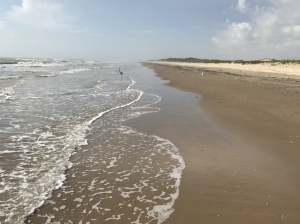
It was somewhat eerie to be on a deserted beach on a hot summer’s day, but the draw of the surf and objects on the glistening sand quickly captured our attention; all thoughts of an apocalyptic death knell drifted away with the tide.
Chapter member Eileen Mattei was on assignment to write a travel article for a Texas magazine. I was invited to take a few photos. Two other friends completed our group.
Generally, people drive up and down Boca Chica Beach, but the entrance was shin-deep in sand. We left the car at the side of the road and set out at a hasty pace, south toward where the Rio Grande spills into the Gulf.
Remnants of Tropical Storm Franklin was still depositing interesting things on the beach. Most noticeable was a beach-long strip of black debris.
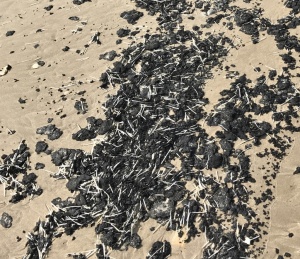
Bunker C fuel oil from the 1940s, we learned later, had hardened into dry, black, rock-like matter. — Oil mixing with sand, shells and seaweed for decades, possibly caught in sandbars off the coast, or buried in the Gulf’s floor, where heavy seas can still dislodge it — made sense to me. . . .
Inch-and-a-half-long strips of white peppered the seasoned tar which most likely were dead seaweed dredged up from the floor of the Gulf, according to chapter sponsor, Texas A&M AgriLife Extension Agent Tony Reisinger, who responded to our text photos and questions.
Shelling wasn’t optimum this day, so we walked along the beach easily avoiding the yard-wide strip of tar by playing in the surf.
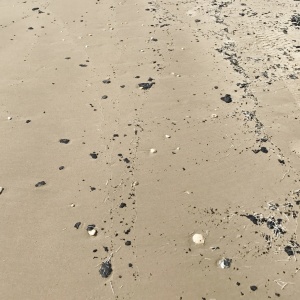
In a later discussion Eileen had with chapter member and Beachcomber Extraordinaire, Diann Ballesteros, Diann explained, “There are always fewer shells washed up in the summer. You see many more in the winter because they belong to tropical creatures who die when it gets the least bit cold farther south.”
Since we were on foot, and had more places to visit for Eileen’s day-trip/staycation story, we didn’t reach the Rio Grande but combed the beach for a mile or so before turning back to investigate the new tidewrack the surf had left behind us.
Eileen found the first (and only) sea bean of the day.
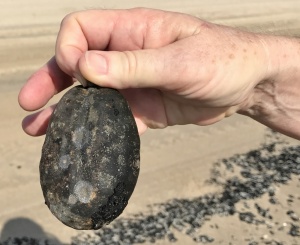
I said, “Bean? No, it looks like it was once a mango.”
“It’s hard as a rock,” she insisted.
“Petrified mango?” I offered.
Eileen later showed the object to Sea Bean Guru Diann. The answer, Brainfruit, Andira galeottiana, or Donovan’s Brain, the fruit of a tree found only in Veracruz and Oaxaca.
A long, lovely shaped piece of driftwood next caught our eye. One end was matted with fuzzy-looking seaweed — the other end offered a colorful surprise.
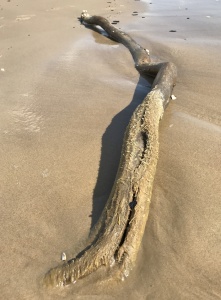
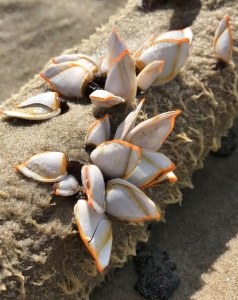
Gooseneck barnacles, Pollicipes pollicipes, thanks to Tony’s text ID. “The French eat them,” he noted.
They made for a great photo op as all four of us aimed our phone cameras.
I looked up a recipe: Chef Jonah Miller, at his restaurant, Huertas, in New York City, “lets their flavors shine by simply boiling them in salt water for 2 to 3 minutes (depending on size), and serving them with a squeeze of lemon.”
A most interesting shell-like “coin” with peacock blue “fringe” was an exciting find.
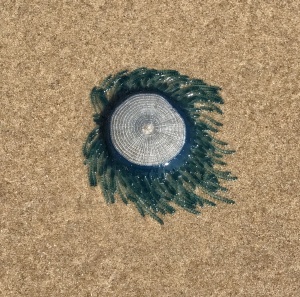
Animal, vegetable or mineral? Again, Tony helped us out — Blue Button, Porpita porpita.
Superficially similar to a jellyfish, it’s a Chondrophore. Internet research explains it:
”The blue button lives on the surface of the sea and consists of two main parts: the float and the hydroid colony. The hard, golden brown float is round, almost flat, and about one-inch wide. The hydroid colony, which can range from bright blue turquoise to yellow, resembles tentacles like those of the jellyfish. Each strand has numerous branchlets, each of which ends in knobs of stinging cells called nematocysts. The blue button sting is not powerful but may cause irritation to human skin.”
Again, our phone cameras clicked. We helped the Blue Button back to the surf using a stranded flip-flop, hoping it wouldn’t get beached again.
The last spectacular find of the day remains a mystery. During our final dip of the morning’s venture, Eileen pulled sparkling, crystal clear seaweed from the waves.
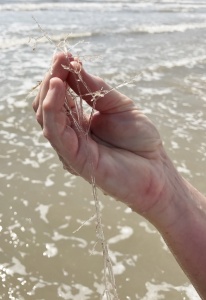
On Tony’s drive back from the beach that evening, he reported that it had been a “no Red Tide day.”
One of the fascinating things about our Rio Grande Valley Texas Master Naturalist chapter is that there’s generally someone who can answer questions and clear up mysteries as we travel through the native habitat, be it land, sea or air. Got a question? Just ask. Someone will know someone who will have an answer. Thank you, Tony and Diann, for answering ours.
If anyone is familiar with our sparkling seaweed, please respond!

Leave a Reply